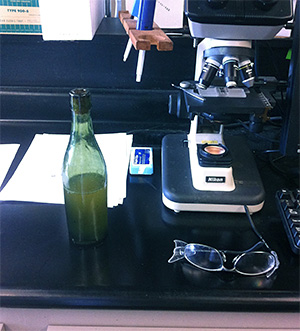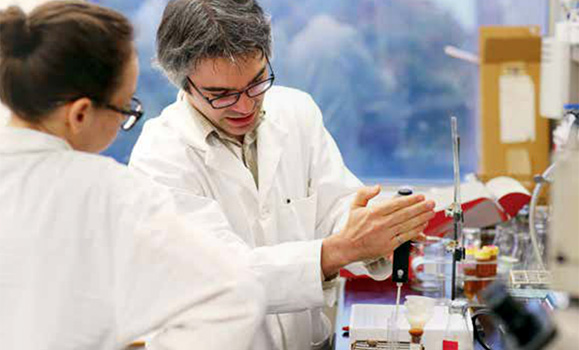A bottle of Alexander KeithÔÇÖs beer has been keeping Dal Engineering prof Andrew MacIntosh busy at work this week.
DonÔÇÖt worry: itÔÇÖs all on the up-and-up. Dr. MacIntosh, from the Department of Process Engineering and Applied Science, has been answering media calls from around the world after helping test a long-lost bottle of Alexander KeithÔÇÖs beer discovered at the bottom of HalifaxÔÇÖs Northwest Arm this fall. The unopened bottle dates back to the 1800s.
ÔÇťIt was far more attention than I expectedÔÇŁ says Dr. MacIntosh. ÔÇťFor some reason this is a story that has really taken off. WeÔÇÖve been in contact with Canadian Press, this morning we chatted with Global News on their breakfast show and [the Discovery Channel TV show] Daily Planet will be airing their segment [in an upcoming episode].ÔÇŁ
The Daily Planet visit, which happened while the tests were taking place, was particularly exciting for Dr. MacIntosh, as he grew up watching the show when it used to be called Discovery CA. ÔÇťIt was quite a pleasure to move from them inspiring me as a kid to working with them now.ÔÇŁ
Lost and found
Amateur scuba diver John Crouse found the bottle in late November last year, near the Northwest ArmÔÇÖs Dingle, buried in the mud under several meters of water. The bottleÔÇÖs markings suggest it dates sometime between 1872 and 1890, with ink preserved on the cork indicating it as a product of ÔÇťA. KeithÔÇÖs Brewers.ÔÇŁ
 The discovery was covered in local news outlets, which is where Dr. MacIntosh heard about it. ÔÇťI thought to myself that it would be a fun opportunity to test that,ÔÇŁ he recalls.
The discovery was covered in local news outlets, which is where Dr. MacIntosh heard about it. ÔÇťI thought to myself that it would be a fun opportunity to test that,ÔÇŁ he recalls.
Another person who noticed the news coverage was Christopher Reynolds of HalifaxÔÇÖs Stillwell Beer Bar. He approached Crouse and, together, decided to get the bottleÔÇÖs contents tested.
ÔÇťThey contacted Propeller [Brewery],ÔÇŁ says Dr. MacIntosh, ÔÇťand their QA manager Jessica Forbes is a former student of ours: she went through our Food Science program, and she completed research in the brewing field under Dr. Alex Speers. So she was familiar with the lab and what we are capable of doing so she pointed Chris in our direction.ÔÇŁ
Brew possibilities
A professor of chemical engineering and food science, Dr. MacIntosh says the two fields are very closely related.
ÔÇťI specifically study fermentation which takes many forms,ÔÇŁ he explains. ÔÇť[ThereÔÇÖs] pharmaceutical fermentation, when you are trying to create an antibiotic. We do bio algae fermentation to try to make biofuels and, of course, production of food products such as beers, ciders and eventually spirits.ÔÇŁ Dr. MacIntosh says the department does ÔÇťa lot of work with the local brewing market to try and advance their technologyÔÇŁ and that their connections to the Canadian Institute of Fermentation Technology (CIFT) help make that happen.

(File photo)
Dr. MacIntosh teaches a class called Advanced Brewing Science, which is mostly taken as an elective for Chemical Engineering students. ItÔÇÖs a class thatÔÇÖs well-aligned with the rising popularity of craft brewing.
ÔÇťThe students coming into that course are now more educated than they have been previously about the many different styles, the many different techniques that are used in brewing and that has helped to offer a much more involved course,ÔÇŁ says Dr. MacIntosh. ÔÇťItÔÇÖs really a fun course to teach.ÔÇŁ
Many of the students are able to take what theyÔÇÖve learned into careers in brewing. Dr. MacIntosh says he knows of students working at Olands, Propeller, a brewery in England and one student at a brewing research station in the United States.
ÔÇťItÔÇÖs quite exciting to maintain connections with students who proceed into this field and see how itÔÇÖs being done elsewhere in the world. One of our professors, Alex Spears, is on leave from H┬■╗ş but heÔÇÖs now acting as the chair of the Institute of Brewing and Distilling in Scotland. So weÔÇÖre really able to collaborate with people all around the world.ÔÇŁ
Testing the treasure
Dr. MacIntosh is looking forward to the science that will come from testing the contents of the discovered bottle.
ÔÇťAll of the chemicals that make up the beer, whether itÔÇÖs skunky or buttery, all of those have a peculiar chemical that contributes to that flavor. We can identify those, quantify those and it will give us some clues about the raw materials that were used in the production of that beer. They are set up to do that in Scotland with Dr. Speers, so weÔÇÖve taken a sample that weÔÇÖll be sending to him thatÔÇÖs leaving tomorrow [Friday] and between our two analyses weÔÇÖll be able to paint a complete picture of that beer which we plan to publish.ÔÇŁ
Which begs the question: did Dr. MacIntosh get the chance to taste the 130-year-old brew?
ÔÇťAt the end [of the testing] we had a couple of millilitres left that couldnÔÇÖt go back into the bottle. It tasted terrible. Beer does not age like wine. DonÔÇÖt go drinking random bottles you find in the harbour.ÔÇŁ

